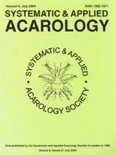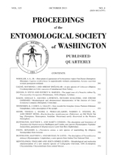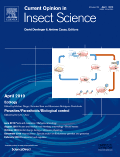
ACAROLOGIA
Scope & Guideline
Illuminating the World of Insect Science
Introduction
Aims and Scopes
- Taxonomy and Systematics:
The journal publishes comprehensive taxonomic studies, including descriptions of new species and revisions of existing taxa, contributing to the classification and understanding of mite biodiversity. - Ecological Interactions:
Research exploring the roles of mites in various ecosystems, including their interactions with plants, animals, and microbial communities, is a key focus area. - Agricultural and Economic Impact:
Studies on the impact of mites as pests or beneficial organisms in agriculture, including biological control strategies and pest management practices, are commonly featured. - Mite Physiology and Development:
The journal includes research on the physiological processes and developmental stages of mites, enhancing knowledge of their life cycles and adaptations. - Environmental Indicators:
Research utilizing mites as bioindicators of environmental health and ecosystem changes, particularly in aquatic and terrestrial habitats.
Trending and Emerging
- Molecular Phylogenetics and Genetics:
An increasing number of studies are employing molecular techniques to explore the genetic relationships among mite species, aiding in more accurate taxonomic classifications and understanding evolutionary processes. - Biological Control Mechanisms:
Research focusing on the use of predatory mites as biological control agents has gained momentum, emphasizing sustainable pest management strategies in agriculture and horticulture. - Climate Change Impact Studies:
There is a growing interest in investigating how climate change affects mite populations, distribution, and ecological interactions, which is critical for predicting future biodiversity patterns. - Host-Mite Interactions:
Emerging research examining the specific interactions between mites and their hosts, particularly in agricultural contexts, is becoming more prevalent, shedding light on co-evolution and ecological dynamics. - Environmental Monitoring and Bioindicators:
The use of mites as bioindicators for environmental health is increasingly recognized, with studies focusing on their role in assessing ecosystem quality and changes in biodiversity.
Declining or Waning
- Traditional Pest Control Methods:
There has been a noticeable decrease in studies solely focused on conventional chemical pest control methods for mites, as researchers increasingly favor integrated pest management approaches that consider ecological impacts. - General Mite Surveys:
While general biodiversity surveys of mite populations were previously common, there is now a trend towards more targeted studies that focus on specific genera or ecological roles, leading to fewer broad surveys being published. - Historical Taxonomic Studies:
Research centered around historical taxonomic classifications without new data or insights has become less frequent, as the field moves towards more data-driven and molecular approaches to taxonomy.
Similar Journals

REVISTA DE LA SOCIEDAD ENTOMOLOGICA ARGENTINA
Innovating Research for a Sustainable FutureREVISTA DE LA SOCIEDAD ENTOMOLOGICA ARGENTINA is an esteemed open-access journal dedicated to the field of entomology, published by the SOCIEDAD ENTOMOLOGICA ARGENTINA. Since its transition to open access in 2013, the journal has sought to promote research in insect science, ecology, and related disciplines, facilitating global dissemination of knowledge and encouraging collaborative studies across borders. Located in the vibrant scientific landscape of La Plata, Argentina, the journal is indexed in Scopus and categorized in the fourth quartile of ecology and insect science, reflecting its commitment to enhancing the discourse within these critical fields. Aiming to bridge the gap between researchers, students, and professionals, REVISTA DE LA SOCIEDAD ENTOMOLOGICA ARGENTINA serves as a platform for innovative research, reviews, and reports on ecological interactions, behavior, and systematic entomology, ultimately driving forward our understanding of insect biodiversity and its broader environmental impacts.

SOCIOBIOLOGY
Fostering Collaboration in Entomological ResearchSOCIOBIOLOGY is a distinguished journal published by the Universidade Estadual de Feira de Santana, focusing on the diverse field of insect science and its implications in agricultural and biological contexts. With its ISSN 0361-6525 and an open access policy established since 2012, the journal prioritizes the dissemination of innovative research, allowing for wider accessibility to its content. Hailing from the United States, it serves as a vital resource for researchers, professionals, and students interested in understanding the complex interactions within insect populations and their environments. As of 2023, SOCIOBIOLOGY holds a reputable position within the academic community, ranking in the third quartile (Q3) in the Insect Science category, with a Scopus rank of #100 out of 181, placing it in the 45th percentile. The journal invites contributions that challenge existing paradigms and explore new frontiers in the ecological and evolutionary dimensions of entomology, fostering a collaborative platform for the sharing of knowledge and advancements within the field.

INTERNATIONAL JOURNAL OF ODONATOLOGY
Unraveling the Mysteries of Insect InteractionsINTERNATIONAL JOURNAL OF ODONATOLOGY, published by Wachholtz Verlag GmbH, is a vital resource for researchers and professionals in the fields of Ecology, Evolution, Behavior, and Insect Science. Established in 1998, this journal provides a platform for the dissemination of innovative research pertaining to odonatology, encompassing the ecological and biological interactions of dragonflies and damselflies. With its focus on advancing knowledge within these scientific disciplines, the journal holds a commendable Q3 ranking in Ecology, Evolution, Behavior and Systematics and a Q2 ranking in Insect Science for 2023, reflecting its significance in academic circles. Although it operates without open access, its articles are accessible through institutional subscriptions, allowing for wide dissemination among scholars and practitioners. The journal's commitment to publishing high-quality, peer-reviewed research makes it an authoritative source of information that enriches the study of odonates and their broader ecological contexts. For inquiries, the journal's editorial team can be reached at C/O Fleet7, Fleethorn 7, Kiel 24103, Germany.

BULLETIN OF INSECTOLOGY
Illuminating the Path of Insect ScienceBULLETIN OF INSECTOLOGY is a prominent academic journal published by ALMA MATER STUDIORUM, UNIV BOLOGNA, Italy, specializing in the field of Insect Science. The journal, with ISSN 1721-8861 and E-ISSN 2283-0332, has established itself as a vital resource for researchers and professionals interested in the diverse aspects of entomology and its applications. It ranks in the Q2 category for Insect Science as of 2023, placing it among the top journals in its field with a Scopus rank of 79 out of 181. The BULLETIN OF INSECTOLOGY is committed to disseminating high-quality research and innovative studies, facilitating open dialogue and collaboration among scientists. As an essential platform for sharing groundbreaking findings, it contributes significantly to the body of knowledge in agricultural and biological sciences, making it an invaluable asset for scholars and practitioners alike. With coverage from 2002 to 2024, this journal continues to foster advancements in entomological research and its importance in tackling environmental challenges.

SYSTEMATIC AND APPLIED ACAROLOGY
Leading the way in acarological research and knowledge sharing.Systematic and Applied Acarology, with ISSN 1362-1971 and E-ISSN 2056-6069, is a leading international journal published by the Systematic & Applied Acarology Society in association with the esteemed Natural History Museum, London. This journal offers a vital platform for researchers in the fields of acarology, ecology, insect science, and evolutionary biology, boasting an impressive impact factor reflecting its significance, particularly with a Q1 ranking in Insect Science and Q2 rankings in Ecology and Evolution, Behavior and Systematics. The open access model ensures that groundbreaking research is readily accessible to a global audience, enhancing collaboration and knowledge sharing. With a scope that encompasses innovative studies, systematic methodologies, and applied acarology research, Systematic and Applied Acarology is committed to advancing the understanding of mite and tick biology, ecology, and their interactions within ecosystems. The journal continues to thrive as an essential resource for students, professionals, and researchers keen on pioneering studies in acarology, making impactful contributions to the scientific community.

Frontiers in Insect Science
Connecting Scholars in the World of InsectsFrontiers in Insect Science is a pioneering open-access journal dedicated to the advancement of knowledge in the field of insect science. Published by FRONTIERS MEDIA SA in Switzerland, this journal serves as a vital platform for researchers, professionals, and students to disseminate high-quality, peer-reviewed research spanning diverse topics within insect biology, ecology, and pest management. Since its establishment in 2021, the journal has gained recognition, ranking in the Q2 category of Insect Science with a Scopus ranking of #92 out of 181 in the field. With a commitment to promoting open access and collaboration, Frontiers in Insect Science is instrumental in fostering innovative research and practical applications essential for combating biodiversity loss and enhancing agricultural sustainability. As a freely accessible resource, it invites contributions that impact both fundamental and applied insect research, connecting a global network of scholars eager to explore the fascinating world of insects.

PROCEEDINGS OF THE ENTOMOLOGICAL SOCIETY OF WASHINGTON
Elevating Entomological Knowledge Since 1981Proceedings of the Entomological Society of Washington is a distinguished journal dedicated to the field of entomology, published by the Entomological Society of Washington. With a rich history dating back to 1981 and a commitment to fostering scientific discourse, this journal serves as a vital platform for researchers and professionals specializing in insect science and ecology. It holds a respectable<> impact factor and is categorized in the Q3 quartile in both Ecology, Evolution, Behavior and Systematics and Insect Science, indicating its relevance within the scientific community. Although it does not offer open access, it provides a curated selection of high-quality research articles that significantly contribute to the understanding of insect biology, behavior, and taxonomy. The journal aims to bridge gaps in current research and inspire innovations in entomological studies, making it an essential resource for students, researchers, and practitioners in the field.

CANADIAN ENTOMOLOGIST
Bridging the Gap Between Insect Behavior and EnvironmentCanadian Entomologist, published by Cambridge University Press, is a prominent journal dedicated to the field of entomology, covering key areas such as insect science, ecology, and evolutionary biology. With its origins dating back to 1868, this esteemed journal has continuously contributed to the understanding of insect behavior, systematics, and physiology, engaging researchers and professionals alike. Although currently not an Open Access journal, it offers valuable insights through its rigorously peer-reviewed articles, reflecting its commitment to scientific excellence. The journal has garnered a respectable Q3 ranking in various categories, including Ecology, Evolution, Behavior, and Systematics, making it a critical resource for scholars and students who seek to explore the complex interactions within insect populations and their environments. Researchers can trust Canadian Entomologist to provide relevant and impactful research that shapes contemporary understanding in the realm of entomological studies, fostering the growth of this vital scientific discipline.

INTERNATIONAL JOURNAL OF ACAROLOGY
Fostering Collaboration in the Study of Mites and TicksThe INTERNATIONAL JOURNAL OF ACAROLOGY is a leading scholarly journal published by TAYLOR & FRANCIS INC, focusing on the multidisciplinary study of acari (mites and ticks) as well as their ecological and economic impact. With an ISSN of 0164-7954 and an E-ISSN of 1945-3892, this journal has been a pivotal resource since its inception in 1975, now converging into 2024 with an emphasis on high-quality research in the field. The journal currently holds a commendable Q2 ranking in Insect Science within the Scopus database, placing it at the 58th percentile among its peers. This emphasizes the journal’s credibility and relevance in advancing scientific understanding, making it an essential platform for researchers, professionals, and students alike dedicated to acariology and related disciplines. Although it does not provide open access, the journal's scope continues to drive significant discourse and innovation, promoting collaboration and the dissemination of critical findings in agricultural and biological sciences.

Current Opinion in Insect Science
Unraveling the Mysteries of Insect LifeCurrent Opinion in Insect Science is a leading academic journal published by ELSEVIER, dedicated to advancing understanding in the field of insect science. With an impressive impact factor reflected in its top quartile rankings (Q1) within both Ecology, Evolution, Behavior and Systematics and Insect Science, the journal holds a prominent position, ranking 3rd out of 181 journals in Insect Science and 35th out of 721 in Ecology-related fields according to Scopus for 2023. Since its inception in 2014, the journal has provided a dynamic platform for researchers, professionals, and students to explore and share cutting-edge developments and insights, targeting crucial topics in insect biology, ecology, and systematics. Although there are no open access options available, Current Opinion in Insect Science remains an essential resource for those looking to stay at the forefront of their research or academic interests.